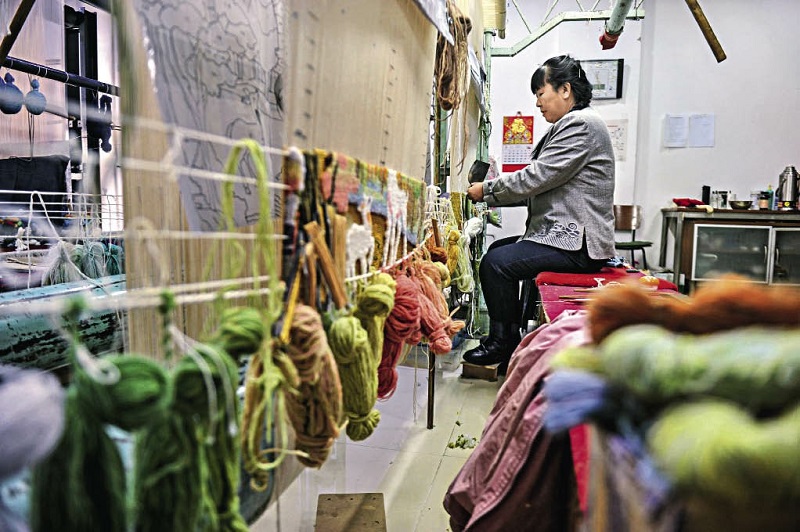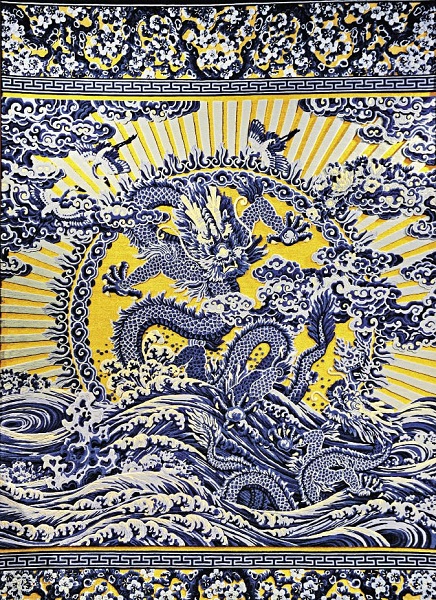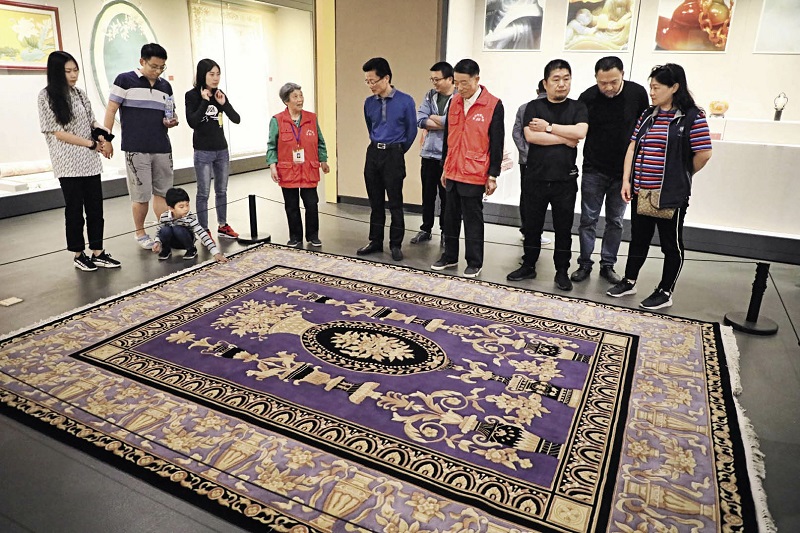DURING French President Emmanuel Macron’s state visit to the U.K. in January 2018, he pledged to lend the Bayeux Tapestry, a national treasure of France, to the U.K., dubbing the move as “tapestry diplomacy.” Just as precious as the Chinese scroll painting masterpiece Qingming Festival at the Riverside, the Bayeux Tapestry was made over a millennia ago, and was listed on the Memory of the World list by the UNESCO in 2007.
In ancient Europe, carpets were a symbol of aristocratic lifestyle. As one of the world’s carpet birthplaces, China also has a history of more than 2,000 years of carpet making. In the courts of the Yuan (1271-1368), Ming (1368-1644), and Qing (1644-1911) dynasties, carpet making agencies were set up to make furnishings for the royal palace, and the weaving skills of palace carpets flourished. Later as time passed, the skill of carpet weaving gradually spread among the ordinary people.

Wang Guoying preparing different colors of thread to use in weaving a palace carpet at her workshop in Beijing.
History
Carpet weaving skills were first introduced into inland China from the Western Regions (a Han Dynasty term for the area west of Yumenguan, including what is now Xinjiang and parts of Central Asia) in the Western Han Dynasty (206 BC-AD 24), and by the Tang Dynasty (618-907), carpet weaving in China’s central plains had become mature. The Yuan Dynasty witnessed strong growth of a carpet weaving industry as carpets were favored by royalty and dignitaries. To localize the skills, a palace weaving agency in the Qingta Temple in Beijing was set up in the Yuan Dynasty, specializing in manufacturing palace carpets.
There were carpet manufacturing agencies respectively during the Ming and Qing dynasties, and palace carpet manufacturing entered its peak during the reign of Emperor Qianlong (1736-1795) in the Qing Dynasty. It was also during this period that the art of palace carpets was gradually introduced to the general public, and dignitaries ordered tailor-made carpets as a symbol of status.
Gradually with the passing of time, the patterns used in making Beijing palace carpets became established: patterns and colors used in the art works of different ethnic groups were combined. Combining traditional Chinese art and Beijing’s palace art, Beijing palace carpets were called Beijing-style carpets, displaying both royal and folk elements.
After the founding of the People’s Republic of China in 1949, palace carpet weaving, as one of China’s export industries, was preserved and developed. A number of carpet factories were set up across China, attracting many young people to join. Hu Jianjuan, now 65 years old, has been studying traditional Chinese painting since she was a child. After graduating from middle school, she joined Tianjin No. 6 Carpet Factory, and began to draw carpet patterns. She still keeps a lot of design drafts from years ago, including some precious palace carpet design drawings.
Some people of her generation might have only thought about locating a good job with the skills they had, but to be able to shoulder the responsibility of passing on the craft takes years of hard tedious work. “Palace carpets exhibit deep cultural connotations,” she said. “Over time I have really come to understand the charm of this art.”

A gold palace carpet with the pattern of a dragon, the epitome of dignity and nobility in China, woven in the center.
The Plight
Wang Guoying, now 52 years old, started to work in Beijing No. 5 Carpet Factory after graduating from a vocational school in 1986. Fascinated by the weaving skills of palace carpets, she joined the new product trial workshop of the carpet factory, specializing in the research and development of new products. Wang enjoyed the achievement brought about by designing and creating carpets at her post, and has persevered all the way to become “the fifth generation successor of the palace carpet weaving craft.”
The process of carpet weaving is basically divided into three major steps: preparation, weaving, and beautifying. During the process of preparing, an artisan needs to design a pattern, spin and dye thread, and get other raw materials ready. The weaving process begins with color coordinating. The last step is to flatten, trim, and cut the semi-finished product.
Weaving is the most time-consuming step of the whole process. It requires great patience and usually takes from six to 12 months to finish one piece. In the hands of ingenious artisans, threads and knots are interwoven into colorful tapestries. There is a special crossed knot, which is a key part of palace carpets, and frames the basic structure of a woven carpet.
It took Wang more than three decades to become a master of palace carpet weaving, and the journey was far from smooth. During her career, she has witnessed the heyday of the traditional handcraft industry, watched it decline, and now seen it revive.
In the 1980s, the palace carpet weaving industry was at its peak. The Beijing Carpet Company had 11 factories and as many as 5,000 employees. The factory where Wang worked was the smallest, with several hundred workers. But it produced a large number of carpets and tapestries for export every year.
In the 1990s, with the boom of China’s market economy, production technologies underwent a great transformation, machine-made carpets mushroomed, and as a result, hand-made ones suddenly became obsolete. The old factories went out of business one by one, and young people lost interest in joining this industry.
The No. 5 factory where Wang worked saw a plunge in its production orders and sales volumes, and it became quite a mental drain. The number of workers in the trial-production workshop also shrank from about 20 at its peak to only two. Wang became quite desperate about the future of her beloved work.

Visitors appreciate a palace carpet at the exhibition of “Eight Wonders of Beijing: Intangible Cultural Heritage of Royal Handicrafts.”
A Turning Point
A turning point appeared at the beginning of this century, when more and more people came to realize the importance of traditional handicrafts in the inheritance of Chinese culture. Sponsored by the government, Wang and her colleagues began to dig for the lost skills in the weaving of gold carpets.
Gold carpets are the most exquisite of the palace carpets. They are made of gold threads, which makes them particularly magnificent. “We only heard of it but nobody had ever seen it,” Wang Guoying talked about the difficulties they once faced in 2003 when they teamed up to look for samples of gold carpets.
“Then we heard that there was a gold blanket at the Palace Museum, so we went there and finally saw a real piece! However we could only look at it behind glass, and our first trial production failed.”
They visited the Palace Museum again, uncertain whether or not they would be allowed to study the structure of the gold carpet with a microscope. Fortunately, they got the permission. After two years of repeated trial and experiment, in 2005 they finally succeeded in making a gold carpet very similar to the piece at the Palace Museum.
In 2008, the weaving technique of Beijing palace carpet was listed as a national intangible cultural heritage protection project, and Wang became a municipal-level recognized representative inheritor.
Meanwhile, the No. 5 Carpet Factory merged with the Beijing Huafang Cultural Development Company, and became Beijing Huafang Carpets Art Company. Starting from 2015, they began hiring workers, and in two years, had built an art inheritance system of palace carpets featuring gold carpets. Their products have been adapted to meet the needs of the market. In the eyes of Wang, this is the step back from the brink of losing a beautiful old art.
“This craft is intimidating to many artisans as the process is long and tedious. It normally takes over half a year to finish just one piece of work,” said Wang. In the eyes of Wang, love, passion, and a peaceful mind come first to anyone who wants to enter this industry, “Traditional artisans are devoted wholly to doing one thing perfect.”
At present, seven students of Beijing Huafang Carpets Art Company have been admitted into Beijing Institute of Fashion Technology (BIFT) to receive systematic education. “Young people are full of ideas and are lucky to grow up in a time when traditional craftsmanship is highly valued. Artisans like me are also willing to keep learning in my area,” Wang joked that she is still young compared with many master craftsmen and inheritors. She is in her early 50s and is full of ideas and confidence for the future of palace carpet weaving.